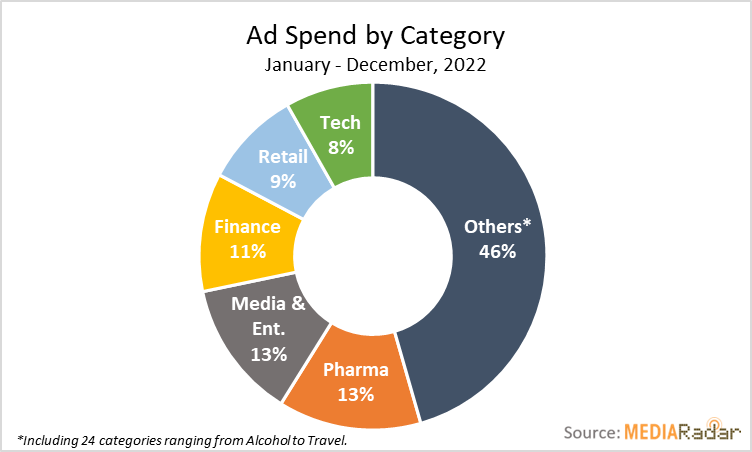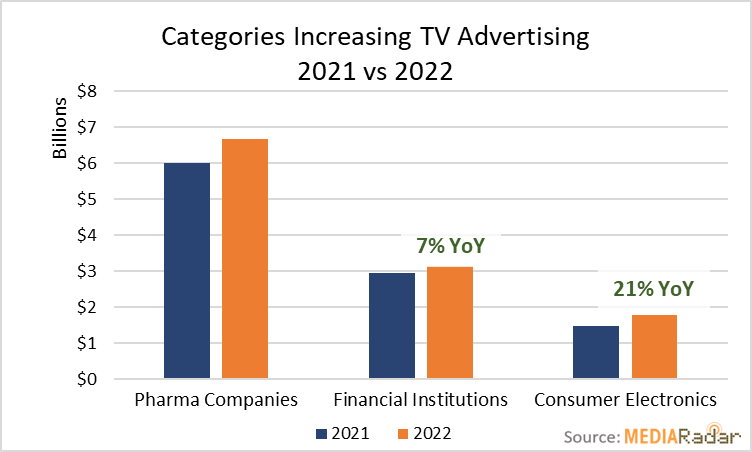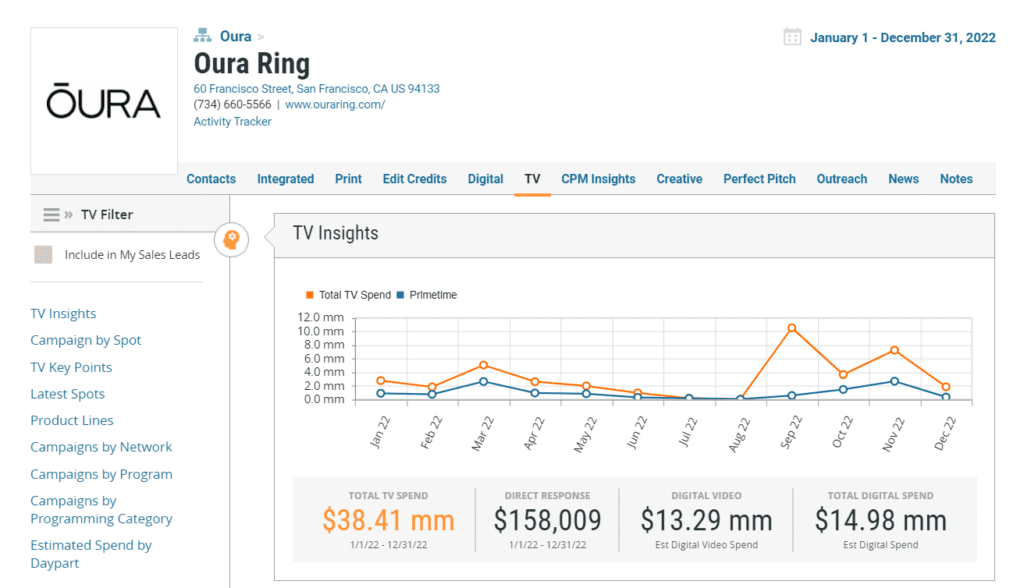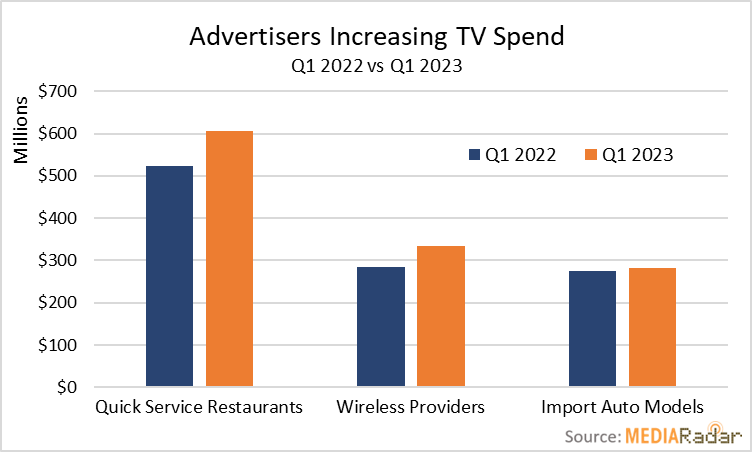Digital ad spending is expected to reach $626b in 2023, up by 10.5% following a period of slowed growth during the pandemic. Much of the increase will come from retail and CPG advertisers, but also those in pharma who are still getting their feet wet.
But even as digital formats root themselves in the budgets of brands, TV ads are still a significant piece of the pie. Here’s how much brands spent on TV ads in 2022 and how they’re performing so far in 2023.

TV Still Captivates Consumers and Advertisers
You don’t hear about TV ads nearly as much as their digital doppelgangers. For example, when Netflix introduced an ad-supported tier, the news made waves.
Shakeups to broadcast and cable TV players generally don’t make as much noise—outside of the Super Bowl when brands spend millions—but that doesn’t mean advertisers aren’t investing in the format.
In 2022, 250k advertisers spent nearly $60b on TV ads, representing a 3% YoY increase from 2021.
True to form, pharma advertisers remained in the safe confines of TV, but other more digitally prone advertisers are investing as well, including those in the media & entertainment (up 15% to $7.6b), finance and real estate (down 5% to $6.6b), retail (down by 3% to $5.4b), and technology (down by 2% to $4.9b) industries.

Overall, advertisers in these categories spent $39.4b (55% of the total investment) on TV ads last year. That said, only some of them increased their investment: pharma, financial institutions, and consumer electronics.

Pharma advertisers stay loyal
After decades of showing little interest in digital, advertisers took notice in 2017 when their digital ad investment jumped by ~170% YoY to almost $6b. By 2024, that number’s expected to approach $20b. (For comparison, it’s estimated that retail advertisers will spend more than $66b this year.)
Pharma advertisers’ shift in strategy in search of digital-first healthcare professionals (HCPs) is long overdue, but it hasn’t fractured their relationship with broadcast and cable TV.
Overall, pharma advertisers promoting over-the-counter (OTC) meds, medical devices, and companies spent more than $7.9b on TV in 2022, up 12% YoY.
Much of that investment came from advertisers promoting arthritis (up by 1% to $471mm), HIV/AIDS, and asthma (up 24% to $308mm) medications; advertisers in each of these categories spent more than $300mm on TV.
The biggest increase, however, came from advertisers for HIV/AIDS medications (up by 42% to $374mm). For example, advertisers for GSK increased their TV budget by 150% YoY to promote Cabenuva following the FDA’s approval last year.
In addition to GSK’s investment in TV, the company launched digital DTC marketing to patients. This cog in its advertising engine illustrates the merger between digital and traditional formats but also the rise of DTC and consumer marketing, two sectors of the advertising world that pharma advertisers have historically shied away from due to regulatory concerns.
Spending was also likely a response to advancements by competing companies. In 2022, the FDA approved Sunlenca (Gilead Sciences), a new HIV drug for adults with limited treatment options.
The spending from GSK reveals the cut-throat nature of pharma and the need for advertisers to up their investments in all formats—TV included—when they bring new medications to the market.
Finance advertisers balance generational differences
Despite the rise of digital banking and finance—mobile banking will grow at a compound annual growth rate (CAGR) of 12.4% through 2026—many finance advertisers are still committed to TV.
In 2022, finance advertisers spent $3b on TV, a 7% YoY increase, driven primarily by those promoting banks, credit cards, and investment firms who accounted for 35% ($1.1b) of the category’s spend.
Advertisers for banks, in particular, spent big—think Bank of America and Chime—increasing their budget by 41% YoY. Meanwhile, advertisers for credit cards and investment firms boosted their investments in TV by X% and X%, respectively.
For finance advertisers, the commitment to TV during the digital shift is likely due to their desire to stay in front of pockets of society who haven’t fully embraced digital means of managing their finances. In fact, Baby Boomers have historically been the generation least interested in digital banking.
The pandemic changed that.
While younger generations have propelled the digital-finance revolution, older generations are warming up to it; 78% of adults in the U.S. now prefer to bank via a mobile app or website.
Finance advertisers set on reaching both sides of the generational coin must shift spending away from TV and into ecosystems where consumers of all ages are spending their time, such as social media and OTT.
Tech titans invest in TV
Overall, technology advertisers decreased their TV budgets in 2022. That said, advertisers promoting consumer electronics did the opposite, increasing theirs by 21% to $1.8b.
Most of the increase from consumer electronics advertisers came from major players, including Apple, Alphabet, and Samsung, who aggressively pushed their cell phones in the perpetual competitive battle for smartphone supremacy.
At the same time, Meta (Facebook’s parent company) upped its investment to promote its virtual reality headset, as did Oura to boost the presence of its Oura Ring.
Qura also integrated its strategy into the NBA with a campaign starring basketball legend Chris Paul.

The surge in TV spending from some advertisers with deep pockets could suggest that the traditional format will only be accessible to those who can bear its immeasurable and often costly nature.
It may also suggest those competing in competitive spaces, like cell phones, will have to use every channel available to woo consumers in their favor, even if it’s not “in vogue.”
TV Ads Hang Around in 2023
Gone are the days when spending on TV ads soars year after year, but that doesn’t mean there will be a complete absence of commercials anytime soon, especially as advertisers seek an effective way to reach consumers without third-party cookies.
Overall, advertisers decreased their investment in TV by 2% in Q1 2023, but they still spent almost $15b, thanks to pharma companies and quick service restaurants (QSR) increasing their budgets by 15% and 16% YoY, respectively.
At the same time, advertisers for cell providers and auto brands boosted their budgets by 17% and 3%.

While TV advertising no longer demands the prime time spot it once did, it’ll continue to secure a spot in budgets as brands and media companies blur the lines between traditional and digital advertising.
As that happens, TV ads will assume a new role.
Will it be a smaller one? Yes.
Will it be any less valuable? A touch, but too many people still watch TV for their value to disappear.
For more insights, sign up for MediaRadar’s blog here.



